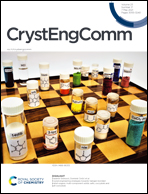Highly efficient fluorescent chemosensor for nitro antibiotic detection based on luminescent coordination polymers with 2,6-di(4-carboxyphenyl)pyrazine†
Abstract
As a critical issue of global concern, antibiotic overuse poses a significant threat to the eco-environment and human health. Here, three isostructural coordination polymers with the formula {[M(DCPP)(H2O)]·(DMF)}n [M = Zn (1), Mn (2) and Co (3); DCPP = 2,6-di(carboxyphenyl)pyrazine)] were synthesized with a solvothermal method and fully characterized. The series of complexes feature 2D bilayer structures, and the layers are stacked parallel to each other into porous supramolecular frameworks through hydrogen bonding interactions. The uncoordinated DMF molecules that exist in the channel participate in hydrogen bonding and stabilize the 3D supramolecular skeleton. As a result, the coordination polymers have good thermal stability and excellent water and organic solvent tolerance. The nitrogen atom serves as Lewis-base sites in the channel, facilitating 1 to anchor and recognize nitro antibiotics, including nitrofurans (NFT and NFZ), nitroimidazoles (ONZ and MNZ) through the fluorescence quenching effect. The nitro antibiotic selective response is quick, and detection limits are reasonably low. Systematic analysis of the sensing mechanism reveals that the cooperative influence of photoinduced electron transfer and fluorescence inner filter effect made complex 1 exhibit special recognition of nitro antibiotics. The efficient identification ability of the new MOF material ensures a promising application in the future.

- This article is part of the themed collection: Coordination Networks


 Please wait while we load your content...
Please wait while we load your content...